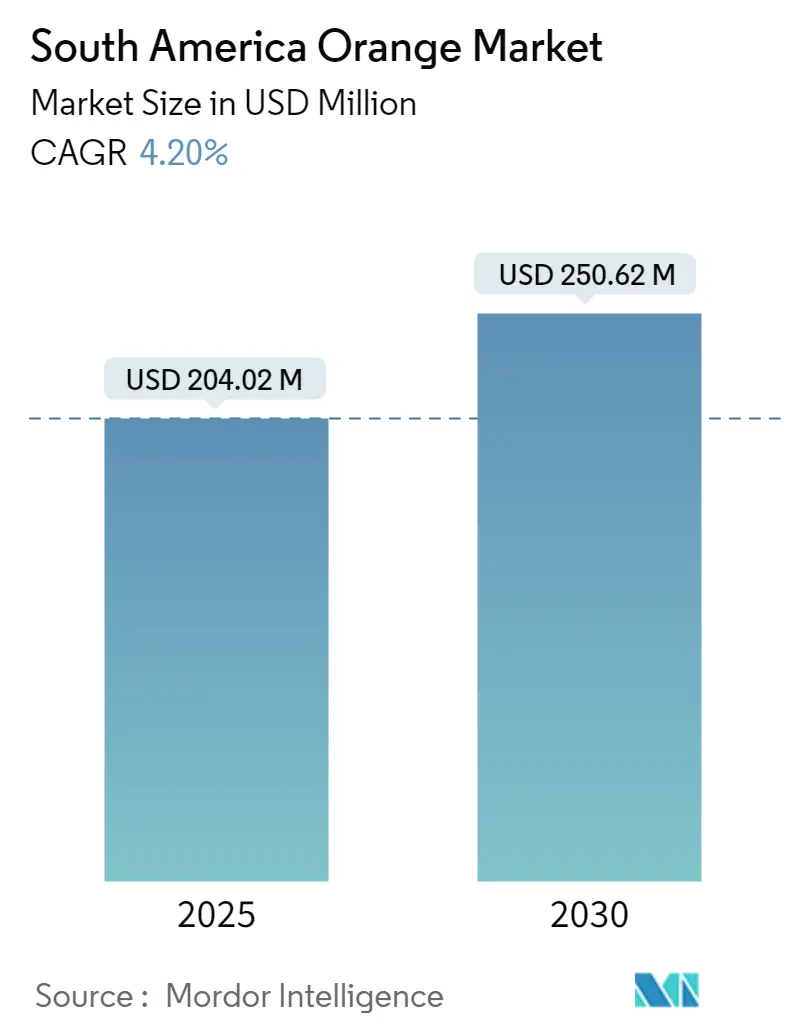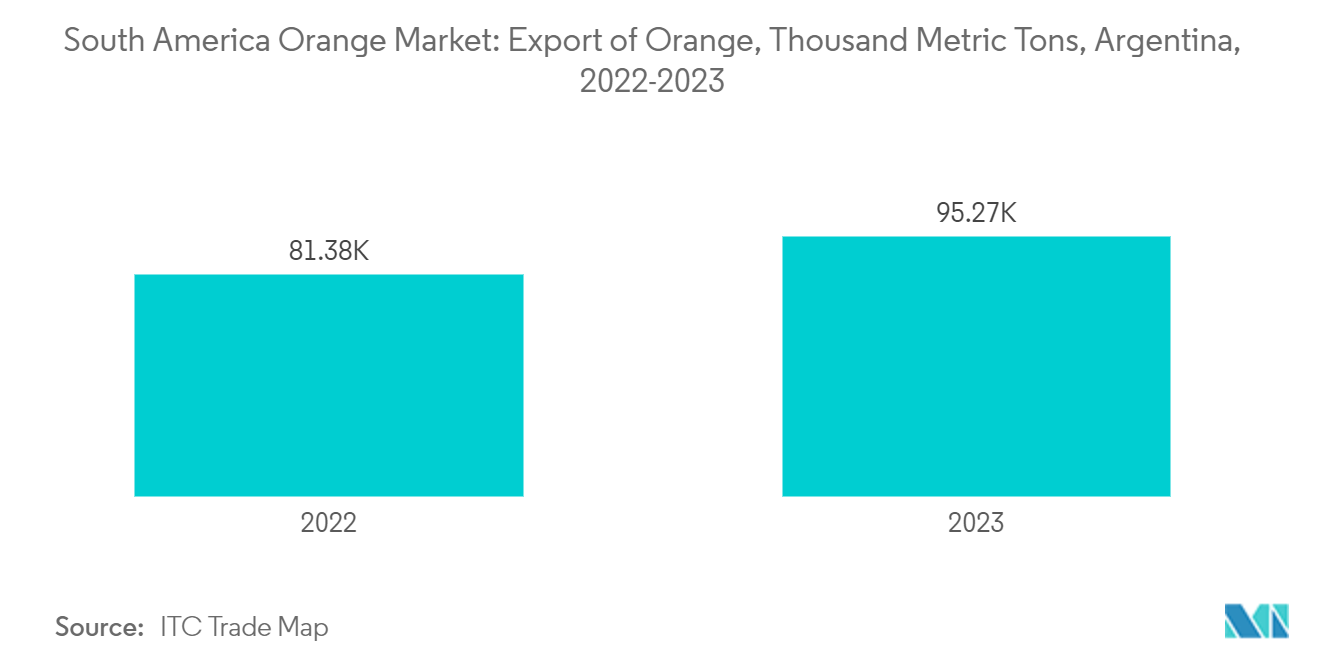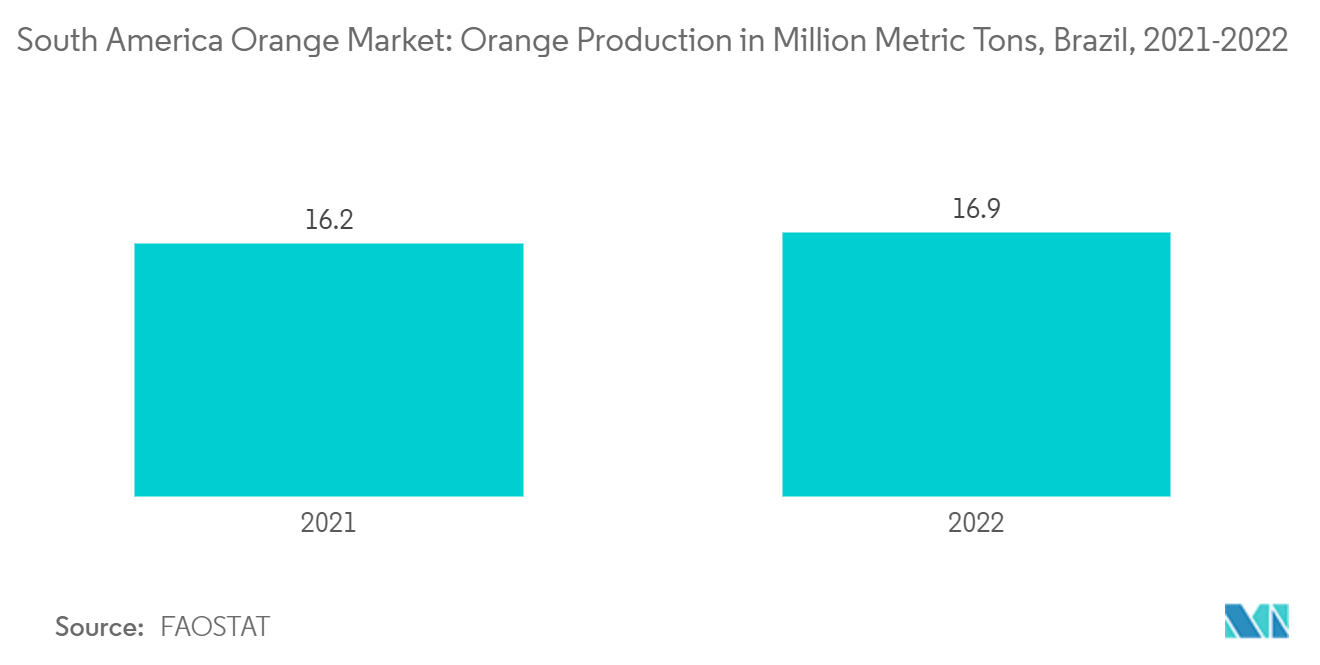
South America Orange Market Analysis by Mordor Intelligence
The South America Orange Market size is estimated at USD 204.02 million in 2025, and is expected to reach USD 250.62 million by 2030, at a CAGR of 4.2% during the forecast period (2025-2030).
- In South America, the orange market holds a pivotal position within the region's expansive agricultural landscape, driven largely by global appetites for both fresh oranges and orange juice. Brazil and Argentina stand out as dominant players, leading the charge in orange production and exportation. While the primary use for these oranges leans towards juice production, a notable portion is also consumed directly Brazil leads the globe as the top producer, with Argentina, Colombia, Paraguay, Chile, and Peru also contributing, though to a lesser extent. Beyond production, South America boasts a vibrant orange trade ecosystem, with Brazil, Argentina, and Chile taking the lead as exporters, while Paraguay and Ecuador emerge as the primary importers.
- According to the FAOSTAT report, in the year 2021, fresh orange production was 19.7 million metric tons which increased to 20.6 million metric tons in 2022. In Argentina, sweet citrus thrives in the northwest (oranges) and northeast (oranges and tangerines). The northwest favors varieties like Hamlin, Pineapple, Robertson, and Navel, while the northeast leans towards Navel, Salustiana, and the enhanced Valencia types, such as Midnight and Delta Seedless. However, the landscape is challenging for smaller producers. Many find it tough to compete, and upon exiting, they often sell their orchards to larger entities.
- Focusing on fresh orange exports, Argentina, Uruguay, and select smaller producers to target European and Asian markets, where there's a pronounced demand for premium quality. On the global stage, Brazil reigns supreme, accounting for over half of the world's orange juice production. A significant portion of this output is Frozen Concentrated Orange Juice (FCOJ), with major exports directed towards the European Union and the United States. While Frozen Concentrated Orange Juice (FCOJ) continues to dominate the global juice landscape, there's a noticeable shift in consumer preference towards NFC (not-from-concentrate) juice, highlighting a desire for fresher, minimally processed options.
South America Orange Market Trends and Insights
Rising Export of Oranges
Chile, Argentina, Uruguay, Colombia, and Brazil lead South America in fresh orange exports. Argentina, a dominant force in the fresh orange export arena, primarily targets European markets, with a keen focus on Spain, the UK, and other EU nations. Furthermore, Argentina is eyeing an expansion into Asian markets, driven by a rising demand for premium fresh produce, fueled by increasing middle-class incomes in nations like China, Japan, and South Korea. This shift underscores Asia's burgeoning significance for South American orange exporters. As disposable incomes rise and a preference for fresh, imported fruits emerge, both Brazil and Argentina are strategically positioning themselves to cater to Asian consumers. By establishing robust supply chains and aligning local import standards, these nations anticipate a significant boost in their export figures in the near future. According to the ITC Trade Map report, in 2022, Argentina's export of oranges was 81,381 thousand metric tons which increased by 95,269 thousand metric tons in 2023. Likewise, in 2022, Chile's export of oranges was 57,215 thousand metric tons which increased by 30,285 thousand metric tons in 2023.
The United States stands out as a primary importer of Brazilian orange juice, supplementing its production, especially from Florida. Brazilian orange juice becomes even more pivotal for the U.S. during challenging years, such as those impacted by hurricanes or diseases. Moreover, to penetrate premium export markets, South American producers are increasingly adopting certifications like Global GAP (Good Agricultural Practices) and other stringent quality and safety standards. Such certifications are not just formalities; they're gateways to exporting success in Europe, North America, and the rapidly evolving Asian markets, where consumers are placing a premium on quality assurance for imported goods.

Brazil Dominates the Market
Brazil stands as the dominant force in the South American orange market, leading the world in both fresh orange and juice production. For instance, according to FAOSTAT, orange production was 16.2 million metric tons in 2022 which increased by 16.9 million metric tons by 2023. This substantial production volume enables Brazil to leverage economies of scale, resulting in production costs that often undercut many global competitors. Moreover, this large-scale output empowers Brazilian producers to remain price-competitive on the world stage, even amidst fluctuations in labor, transportation, and agricultural input costs.
Sao Paulo is the nation's primary orange-producing state. The region's warm subtropical climate, fertile soil, and robust citrus industry infrastructure render it ideal for orange cultivation. While São Paulo leads in orange production, neighboring Minas Gerais is steadily ramping up its output, owing to regions within the state that boast similar soil and climate conditions.
Brazil's orange industry is characterized by its organization, with major players like Citrosuco and Cutrale at the helm, overseeing production, processing, and export. These industry giants have established comprehensive supply chains, processing facilities, and cold storage infrastructures, bolstering Brazil's competitive edge in the global arena. Moreover, Brazil's strategic investments in high-capacity processing plants and storage facilities empower it to export both Frozen Concentrated Orange Juice (FCOJ) and not-from-concentrate (NFC) juice, catering to a wide array of consumer preferences in international markets.

Recent Industry Developments
- December 2022: The producers of Brazil's orange industry have developed a technique known as densification, whereby more citrus trees are planted in the same area to increase fruit yield in a major citrus belt like Sao Paulo State and the western portion of Minas Gerais State.
- August 2022: Solidaridad launched Fruto Resiliente, a project to strengthen sustainable orange production in Brazil. The initiative aims to encourage good agricultural practices by promoting good management of rural properties and strengthening the production of almost 500 small and small farmers. By providing training, accessible information, and hands-on technical assistance, this project continues to support small orange farmers to adapt to environmental and labor standards while remaining competitive.
South America Orange Market Report Scope
Oranges are a type of low-calorie, highly nutritious citrus fruit. As part of a healthful and varied diet, oranges contribute to strong, clear skin and can help lower a person's risk of many conditions. Oranges are popular due to their natural sweetness, the many different types available, and the diversity of uses. The South American orange market is segmented by geography into Brazil, Argentina, Venezuela, and Chile. The report offers an analysis of production (volume), consumption (value and volume), import (value and volume), export (value and volume), and price trend analysis. The report offers market size and forecasts in terms of value (USD) and volume (metric tons) for all the above segments.
| Brazil | Production Analysis |
| Consumption Analysis and Market Value | |
| Import Market Analysis (Volume and Value) | |
| Export Market Analysis (Volume and Value) | |
| Price Trend Analysis | |
| Argentina | Production Analysis |
| Consumption Analysis and Market Value | |
| Import Market Analysis (Volume and Value) | |
| Export Market Analysis (Volume and Value) | |
| Price Trend Analysis | |
| Venezuela | Production Analysis |
| Consumption Analysis and Market Value | |
| Import Market Analysis (Volume and Value) | |
| Export Market Analysis (Volume and Value) | |
| Price Trend Analysis | |
| Chile | Production Analysis |
| Consumption Analysis and Market Value | |
| Import Market Analysis (Volume and Value) | |
| Export Market Analysis (Volume and Value) | |
| Price Trend Analysis |
| Geography | Brazil | Production Analysis |
| Consumption Analysis and Market Value | ||
| Import Market Analysis (Volume and Value) | ||
| Export Market Analysis (Volume and Value) | ||
| Price Trend Analysis | ||
| Argentina | Production Analysis | |
| Consumption Analysis and Market Value | ||
| Import Market Analysis (Volume and Value) | ||
| Export Market Analysis (Volume and Value) | ||
| Price Trend Analysis | ||
| Venezuela | Production Analysis | |
| Consumption Analysis and Market Value | ||
| Import Market Analysis (Volume and Value) | ||
| Export Market Analysis (Volume and Value) | ||
| Price Trend Analysis | ||
| Chile | Production Analysis | |
| Consumption Analysis and Market Value | ||
| Import Market Analysis (Volume and Value) | ||
| Export Market Analysis (Volume and Value) | ||
| Price Trend Analysis | ||
Key Questions Answered in the Report
How big is the South America Orange Market?
The South America Orange Market size is expected to reach USD 204.02 million in 2025 and grow at a CAGR of 4.20% to reach USD 250.62 million by 2030.
What is the current South America Orange Market size?
In 2025, the South America Orange Market size is expected to reach USD 204.02 million.
What years does this South America Orange Market cover, and what was the market size in 2024?
In 2024, the South America Orange Market size was estimated at USD 195.45 million. The report covers the South America Orange Market historical market size for years: 2019, 2020, 2021, 2022, 2023 and 2024. The report also forecasts the South America Orange Market size for years: 2025, 2026, 2027, 2028, 2029 and 2030.
Page last updated on:
South America Orange Market Report
Statistics for the 2025 South America Orange market share, size and revenue growth rate, created by Mordor Intelligence™ Industry Reports. South America Orange analysis includes a market forecast outlook for 2025 to 2030 and historical overview. Get a sample of this industry analysis as a free report PDF download.


